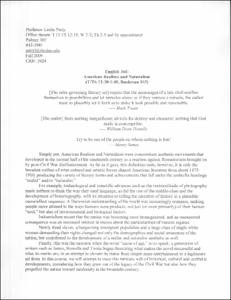Please use this identifier to cite or link to this item:
http://hdl.handle.net/10267/4889Full metadata record
| DC Field | Value | Language |
|---|---|---|
| dc.contributor.author | Petty, Leslie | - |
| dc.date.accessioned | 2009-12-03T17:52:37Z | - |
| dc.date.available | 2009-12-03T17:52:37Z | - |
| dc.date.issued | 2009-08-26 | - |
| dc.identifier.uri | http://hdl.handle.net/10267/4889 | - |
| dc.description | This syllabus was submitted to the Office of Academic Affairs by the course instructor. | en_US |
| dc.description.abstract | Simply put, American Realism and Naturalism were concomitant aesthetic movements that developed in the second half of the nineteenth century as a reaction against Romanticism brought on by post-Civil War disillusionment.A s far as it goes,t his definition suits;h owever,i t is only the broadest outline ofwhat cultural and artistic forces shaped American literature from about 1875- 1910, producing the variety of literary forms and achievementsth at fall under the urnbrella headings "realist" and/or ohaturalist." For example,t echnologicaal nd scientifica dvancess ucha s the verisimilitudeo fphotography made authors re-think the way they used language, as did the rise of the middle-class and the development of historiography, with its attention to telling the narrative of history in a plausible cause/effects equenceA. Darwinian understandingo f the world was increasingly cofiunon, making people more attuned to the ways humans were products, not just (or even primarily) of their human "soul," but alsoo f environmentaal ndb iological factors. Industrialism meant that the nation was becoming more homogenized, and an unexpected consequencew as an increasedi nterest in storiesa bout the particularities of various regions. Newly freed slaves, a burgeoning immigrant population and a large class of single white women demandingt heir rights changedn ot only the demographicsa nd social awarenesso f the nation, but contributed to the development of a realist and naturalist aesthetic as well. Finally, this was the moment when the novel "came of age," so to speak; a generation of writers such as James, Howells and Twain began theorizing what makes the novel successful and what its merits are, in an attempt to elevate its status from simple mass entertainment to a legitimate art form. In this course, we will attempt to trace this intricate web ofhistorical, cultural and aesthetic developments, considering how they grew out of the legacy of the Civil War but also how they propelled the nation toward modernity in the twentieth-century. | en_US |
| dc.language.iso | en_US | en_US |
| dc.publisher | Memphis, Tenn. : Rhodes College | en_US |
| dc.relation.ispartofseries | Syllabi CRN;10240 | - |
| dc.rights | Rhodes College owns the rights to the digital objects in this collection. Objects are made available for educational use only and may not be used for any non-educational or commercial purpose. Approved educational uses include private research and scholarship, teaching, and student projects. For additional information please contact archives@rhodes.edu. Fees may apply. | - |
| dc.subject | English, Department of | en_US |
| dc.subject | Syllabus | en_US |
| dc.subject | Curriculum | en_US |
| dc.subject | Academic departments | en_US |
| dc.subject | Text | en_US |
| dc.subject | 2009 Fall | en_US |
| dc.title | ENGL 361-01, American Realism and Naturalism, Fall 2009 | en_US |
| dc.type | Syllabus | en_US |
| Appears in Collections: | Course Syllabi | |
Files in This Item:
| File | Description | Size | Format | |
|---|---|---|---|---|
| 2009_FALL_ENGL_361_01-10240.PDF | 2.05 MB | Adobe PDF |  View/Open |
Items in DSpace are protected by copyright, with all rights reserved, unless otherwise indicated.